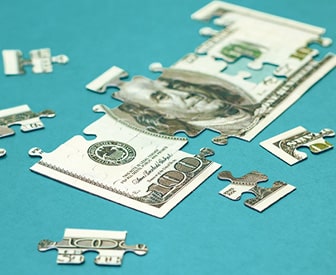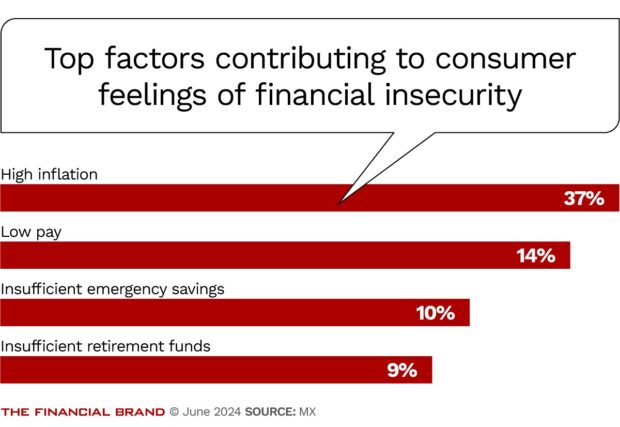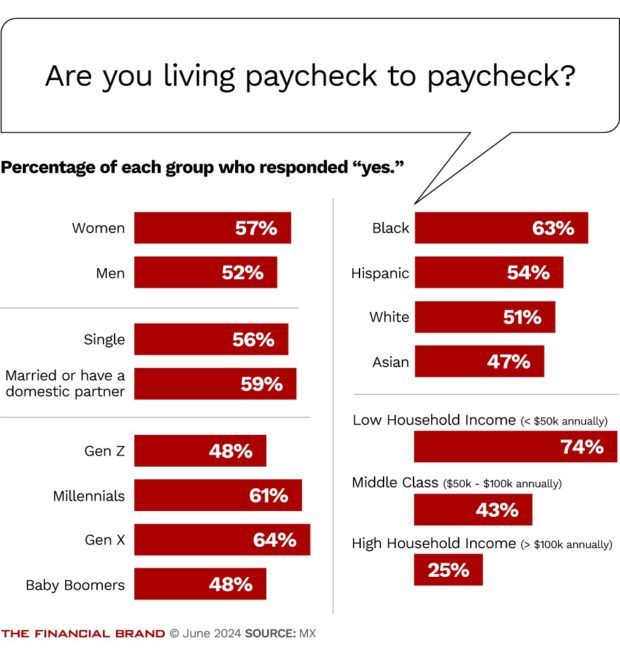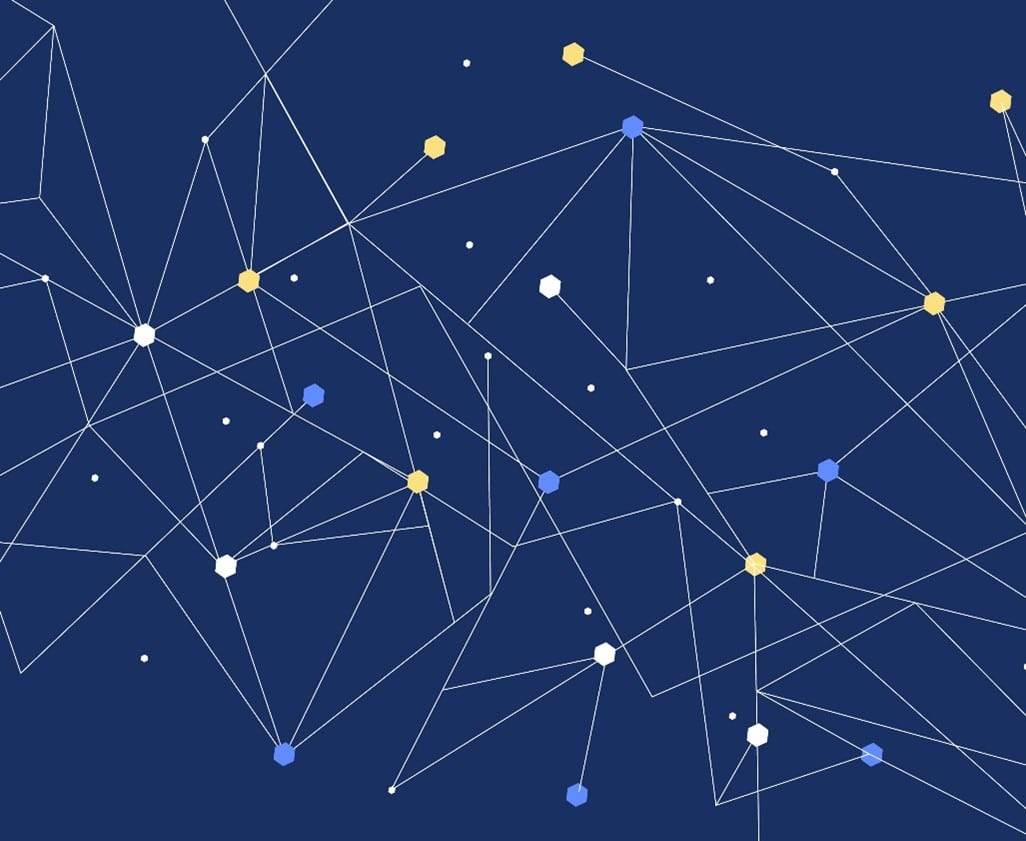The report: How to Drive Engagement When Consumers Refuse to Change
Source: MX
Why we picked it: We won’t lie: The headline was a particularly intriguing element of this report. It didn’t stop at a snappy title though — MX’s latest release, albeit short, provided up-to-date insight into consumer payments and banking behaviors that are otherwise hard to find in peer reports.
Executive Summary
The 2024 economy doesn’t feel like it’s getting any better as the year goes on, and consumers across the country are feeling battered by high inflation and rising costs of living. Despite the greater trends, however, new research shows there are also good chunks of U.S. consumers that are optimistic about their future, and even about their current financial state.
An MX report — which polled consumers in the first quarter of 2024 – found one in four respondents actually feel completely financially secure. The other side of the coin, however, shows that many are stuck in old habits when it comes to managing their money.
The report, which compiles answers from a survey of over 1,000 U.S. adults, dives into how consumers define financial security, their preferred methods for bill payments, credit card usage, direct deposit trends and growing expectations for personalized banking experiences.
Key Takeaways:
- 55% of consumers say they are living “paycheck to paycheck,” but not every person defines that phrase the same way
- 64% of consumers still prefer to manually pay bills each month, presenting an opportunity for financial providers to offer personalized alerts and automate the process
- 25% of consumers don’t have a credit card, a significant increase from 17% a year ago. Usage varies greatly by demographics
- While most consumers (65%) have never switched their direct deposit to a different institution, incentives could be key to encouraging them to do so

Improve Your Business Outcomes Through Data & Analytics
Gain centralized access to the credit bureaus and 20+ alternative data sources. Leverage advanced analytics to optimize marketing campaigns and loan decisions.
Read More about Improve Your Business Outcomes Through Data & Analytics

Solving the Deposit Puzzle: Strategies for Growth in Rate Uncertainty
Join Kasasa’s insightful webinar to explore effective strategies for navigating the complexities of rate uncertainty.
Read More about Solving the Deposit Puzzle: Strategies for Growth in Rate Uncertainty
Redefining Financial Security
How would you define “living paycheck to paycheck?” The meaning of this phrase can vary greatly depending on who you talk to.
MX found that only 21% equate it to being unable to pay bills without their next paycheck. More commonly, it’s perceived as the inability to sufficiently save (32%) or contribute to savings/retirement in addition to covering bills (30%).
The generational divide in financial optimism is particularly striking. Gen Z, despite being the most likely to report living paycheck to paycheck, also expresses the most confidence in their eventual financial security. This may reflect a longer-term perspective shaped by their stage of life. Conversely, Baby Boomers are the least likely to feel they’ll ever be financially secure, perhaps due to the looming pressures of retirement.
Additionally, the report highlights a disconnect between consumer optimism and the realities of financial insecurity. While 56% believe they will be financially secure someday, many still struggle with the impact of high inflation, low pay, insufficient savings and retirement funds.
This is especially true for women, Gen Z and low-income households who are more likely to report living paycheck to paycheck. As a whole, one-third of the consumers surveyed say they worry about not having capital to cover unexpected expenses and 15% say they struggle amassing income to cover daily expenses.
Old [Banking] Habits Die Hard
When it comes to bill pay, most consumers are stuck in familiar patterns. Sixty-four percent still prefer to manually pay bills each month, either to keep track of finances (40%) or ensure funds are available (24%). These habits are unlikely to change in the long term — over half say they prefer to maintain their payment methods for the sake of convenience. Even more startling, over a third of people say they’ve never changed how they pay their bills.
When consumers decide to switch methods, it’s often reactively, sometimes due to fraud or an expired card, or insufficient funds (8%). Only 15% proactively changed to earn better rewards.
These trends carry well into their depositing behavior too, the report found. Although MX’s findings don’t mention if it’s loyalty or laziness, 65% of consumers have never switched their direct deposit to a different institution, as part of a very “set it and forget it” behavior. Those who have cite closed accounts (40%), seeking higher interest rates (30%) or switching incentives (17%) as primary reasons.
There is still a small, but significant, 9% of consumers who don’t use direct deposit at all, representing an acquisition opportunity for banks and credit unions. To encourage direct deposit adoption and switching, the report advises leading with incentives such as early access to funds, cash back offers, and higher interest rates. Automated insights on saving and spending could also help consumers optimize how they allocate their paycheck across accounts.
While most consumers (67%) deposit their entire paycheck into one account, there are interesting subsets who split their direct deposits across multiple accounts (17%) or even multiple institutions (7%). This may reflect differing approaches to budgeting and money management. By offering tools to automatically apportion funds according to the consumer’s goals and needs, financial providers could simplify the process and attract these segments.
Read more:
- How Much Do Online Reviews Matter to Banking Decisions? (A Lot.)
- Why Issues with Customer Service Hurt Satisfaction with Direct Banks
- How to Master Deposit Pricing with Data-Driven Personalization
The Credit Card Conundrum
Despite other industry data showing growth in credit card usage, MX found that a quarter consumers don’t have a credit card — up from just 17% a year ago. Usage also varies significantly by demographic:
- 50% of those who make less than $25k annually do not have a credit card
- 33% of single individuals and 33% of Black respondents do not have a credit card
- 32% of Gen X is most likely not to have a credit card
- 16% Gen Z is most likely to use credit cards for emergencies only
Among cardholders, 35% pay their balance in full each month while 28% carry a balance. These tendencies also vary across groups, with Asian respondents most likely to pay in full (49%) and Hispanic respondents most likely to carry a balance (36%). For financial institutions looking to grow their credit card customer base, a segmented approach that accounts for these demographic differences will be essential.
Interestingly, the report suggests that incentives may not be enough to drive significant changes in credit card habits. While 11% say rewards are the most important factor in choosing a payment method, only 15% have ever switched payment methods to earn better rewards. Security (27%) and convenience (22%) still reign supreme. However, with 36% saying they would consider switching for an incentive, there may still be opportunities to sway behavior with the right offer.

Double Down on Mastering Personalization
Looking ahead, consumer expectations for personalized banking experiences are on the rise, especially among younger generations and affluent households. 49% expect their financial provider to know them, 56% expect clear and actionable insights based on their data, and 53% expect personalized experiences. However, only 46% would be willing to share more data in exchange for better experiences.
Meanwhile, financial industry leaders seem to overestimate consumer feelings of financial fragmentation. Fifty-seven percent of leaders believe consumers don’t have a holistic financial view because their money is dispersed across so many accounts. Yet only 14% of consumers agreed with this sentiment, potentially because most see their direct deposit as one concentrated “pot” of money, despite leveraging 5-7 accounts on average.
To bridge this gap, MX asserts that the answer lies in turning data into actionable financial intelligence. Yet challenges remain in applying these personalized insights consistently, especially in marketing communications. Sixty-seven percent of consumers have never acted on a marketing email or direct mail from their financial institution. To drive engagement, providers will need to lean into the power of data-driven personalization.
This may require a significant shift in how financial institutions approach consumer relationships. Rather than broad-brush marketing campaigns, communications will need to be hyper-relevant to the individual’s financial situation and goals. Real-time data and AI-powered insights could help providers deliver the right message at the right moment.
Editor’s note: This article was prepared with AI language software and edited for clarity and accuracy by The Financial Brand editorial team.









